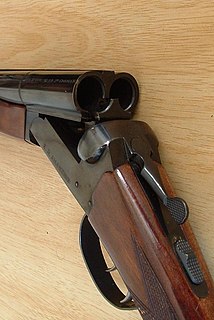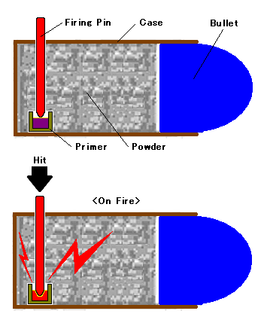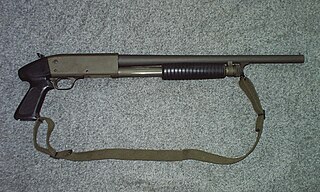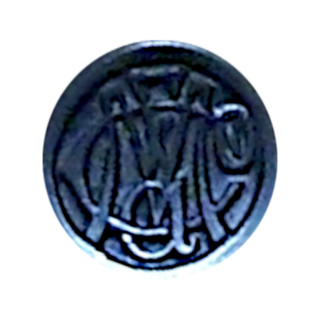
A double-barreled shotgun is a break-action shotgun with two parallel barrels, allowing two single shots to be fired in quick succession.

A shotgun is a long-barreled firearm designed to shoot a straight-walled cartridge known as a shotshell, which usually discharges numerous small pellet-like spherical sub-projectiles called shot, or sometimes a single solid projectile called a slug. Shotguns are most commonly smoothbore firearms, meaning that their gun barrels have no rifling on the inner wall, but rifled barrels for shooting slugs are also available.

Single-shot firearms are firearms that hold only a single round of ammunition, and must be reloaded manually after every shot. The history of firearms began with single-shot designs, then multi-barreled designs appeared, and eventually many centuries passed before multi-shot repeater designs became commonplace.

Meriden is a city in New Haven County, Connecticut, located halfway between the regional cities of New Haven and Hartford. In 2010, the population of the city was 60,868.
The Winchester Model 1897, also known as the Model 97, M97, or Trench Gun, is a pump-action shotgun with an external hammer and tube magazine manufactured by the Winchester Repeating Arms Company. The Model 1897 was an evolution of the Winchester Model 1893 designed by John Browning. From 1897 until 1957, over one million of these shotguns were produced. The Model 1897 was offered in numerous barrel lengths and grades, chambered in 12 and 16 gauge, and as a solid frame or takedown. The 16-gauge guns had a standard barrel length of 28 inches, while 12-gauge guns were furnished with 30-inch length barrels. Special length barrels could be ordered in lengths as short as 20 inches, and as long as 36 inches. Since the time the Model 1897 was first manufactured it has been used by American soldiers, police departments, and hunters.

A gunsmith is a person who repairs, modifies, designs, or builds guns. The occupation differs from an armorer, who usually replaces only worn parts in standard firearms. Gunsmiths do modifications and changes to a firearm that may require a very high level of craftsmanship, requiring the skills of a top-level machinist, a very skilled woodworker, and even an engineer. Gunsmiths perform factory-level repairs and renovations to restore a well-used or deteriorated firearms to new condition. They may make alterations to adapt sporting guns to better fit the individual shooter that may require extensive modifications to the firearm's stocks and metal parts. Repairs and redesigns may require fabrication and fitting of unavailable parts and assemblies constructed by smiths themselves. Gunsmiths may also renew metal finishes or apply decorative carvings or engravings to guns. Many gun shops offer gunsmithing service on the premises.

A pinfire cartridge is an obsolete type of metallic firearm cartridge in which the priming compound is ignited by striking a small pin which protrudes radially from just above the base of the cartridge. Invented by Frenchman Casimir Lefaucheux in the 1830s but not patented until 1835, it was one of the earliest practical designs of a metallic cartridge. Its history is closely associated with the development of the breechloader which replaced muzzle-loading weapons.
The Remington Model 870 is a pump-action shotgun manufactured by Remington Arms Company, LLC. It is widely used by the public for sport shooting, hunting, and self-defense and used by law enforcement and military organizations worldwide.
The Winchester Model 1887 and Winchester Model 1901 are lever-action shotguns originally designed by famed American gun designer John Browning and produced by the Winchester Repeating Arms Company during the late 19th and early 20th centuries. The shotgun has become iconic for its use in the 1991 film Terminator 2: Judgment Day and the video game Call of Duty: Modern Warfare 2.

The Ithaca Gun Company is a manufacturer of shotguns and rifles originally established in Ithaca, New York, in 1880.

The Ithaca 37 is a pump-action shotgun made in large numbers for the civilian, military, and police markets. Based on a 1915 patent by firearms designer John Browning for a shotgun initially marketed as the Remington Model 17, it utilizes a novel combination ejection/loading port on the bottom of the gun which leaves the sides closed to the elements. Since shotshells load and eject from the bottom, operation of the gun is equally convenient for both right- and left-handed shooters. This makes the gun popular with left-handed shooters.
The Winchester Model 1912 is an internal-hammer pump-action shotgun with an external tube magazine. Popularly named the Perfect Repeater at its introduction, it largely set the standard for pump action shotguns over its 51-year high-rate production life. From August 1912 until first discontinued by Winchester in May 1964, nearly two million Model 12 shotguns were produced in various grades and barrel lengths. Initially chambered for 20 gauge only, the 12 and 16 gauge versions came out in 1913, and the 28 gauge version came out in 1934. A .410 version was never produced; instead, a scaled-down version of the Model 12 known as the Model 42, directly derived from scaled drawings of the Model 12, was produced in .410.

A combination gun is a firearm that comprises at least one rifled barrel and one smoothbore barrel, that is typically used with shot or some types of shotgun slug. Most have been break-action guns, although there have been other designs as well. Combination guns using one rifled and one smoothbore barrel usually are in an over and under configuration. Side-by-side versions are referred to as cape guns. A drilling is a combination gun that has three barrels. A vierling has four barrels. Combination guns generally use rimmed cartridges, as rimless cartridges are more difficult to extract from a break-action weapon.
The Winchester Model 21 is a deluxe side by side shotgun. The shotgun's initial production run from 1931 through 1960 yielded approximately 30,000 guns. Winchester Repeating Arms Company ceased the main production line of this shotgun in 1960 and the Model 21 was sourced to the Winchester Custom Shop until the gun's retirement in 1991. New Winchester Model 21 production continues under license to Connecticut Shotgun Manufacturing Company.
A coach gun is a modern term, coined by gun collectors, for a double-barreled shotgun, generally with barrels from 18" to 24" in length placed side-by-side. These weapons were known as "cut-down shotguns" or "messenger's guns" from the use of such shotguns on stagecoaches by shotgun messengers in the American Wild West. They came in 10 and 12 gauge blackpowder.

The Meriden Firearms Company of Meriden, Connecticut, USA manufactured small arms from 1905 to 1918. Meriden manufactured 20 varieties of hammer and hammerless revolvers with an output of 100 handguns a day in 1906. In addition to revolvers the company manufactured shotguns and rifles.
The Ruger Gold Label was a side-by-side double-barreled shotgun that was made by Sturm, Ruger & Company, Incorporated, at their manufacturing facility in Newport, New Hampshire. It was designed to be similar to traditional English shotguns used for upland bird hunting and for clay target games such as sporting clays.
The Cooey 84 is a shotgun manufactured by the H. W. Cooey Machine & Arms Company in Cobourg, Ontario, Canada. The shotgun was sold as model number 84 until 1967, and as model number 840. The gun ceased to be produced in 1979. Today, the 84/840 is considered a collector's item to certain people who collect the Canadian-made firearms.
The Ruger Red Label was an over and under shotgun that was built by Sturm, Ruger & Co. at the direction of William B. Ruger.
The Charles Parker Company (1832-) was formed in Meriden, Connecticut by Charles Parker, and over the years manufactured products including metalware, Art Brass, hardware, lamps, spectacles, and piano stools. Also related to the company were others founded by Charles Parker: including Parker Brothers, Meriden Curtain Fixture Co., and Parker & Whipple Co. clock manufacturers.









